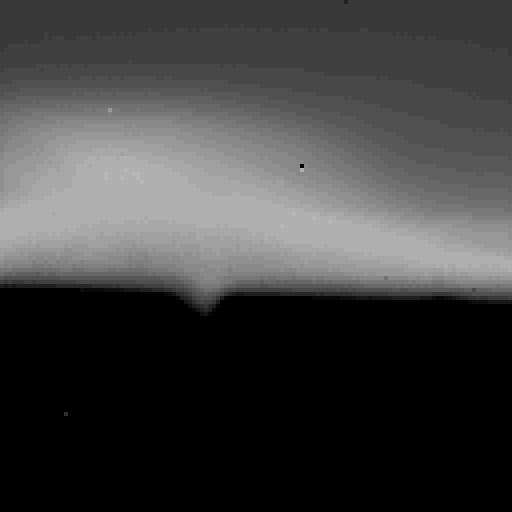Results
Tepmerature Plots from Anneal
The temperature plots are presented in the analysis for mips-900 in this campaign, and can be seen here. The temperature behavior during the anneal was nominal.
24 µm Images
The figure below shows DN images from the reset-read frame from the 3rd DCE of the
RAW exposures taken before and after the thermal anneal (see mips-990_24um.pro). The
images have been scaled linearly from 0 - 5000 DN, and are extremely similar in their
structure. It should be noted that a constant value of 19429 DN were subtracted from
the data from after the anneal, because of the problem with the offset voltage noted
in the abstract. Figure 3 shows the ratio of the after-anneal image to the before-anneal
image. The dark bar across the image is due to a latent image of the pickoff-mirror
edge, which was serendipitously being imaged in the final exposure sequence of mips-950
(CSMM was at the 160 µm dark position, which directs the 24 µm array at one
edge of the pickoff mirror - see Figure 4). It is interesting that the latent, which
is present in the reset-read frame of the RAW exposures, is present only in the region
where the light was bright but unsaturating. There is also some evidence that this
latent decays with a slower timescale than the latents in the slope images. For example,
ratioing the reset-read frame from DCEs 2 and 10 of the before-anneal data does not
show the latent visible in Figure 3.
Figure 1.DN image from the reset-read frame of the 24 µm RAW exposure taken before the thermal anneal on the Si array. Scaling is 0 - 5000 DN.
Figure 2.DN image from the reset-read frame of the 24 µm RAW exposure taken after the thermal anneal, same scaling as above.
Figure 3.Ratio of the image in Fig. 2 to Fig. 1 showing the latent from the pickoff-mirror edge.
Figure 4.Slope image (SUR) from the scattered background test in Campaign C, where the images were much less saturated, and the pickoff-mirror edge is visible. The latent artifact visible in Figure 3 coincides with the edge of the pickoff-mirror in this image, which would be in the same place as in the Campaign B data. NOTE that the bottom of the image is saturated (0 slope), and the light seen in the upper part of the image is scattered light (the notch in the pickoff mirror points into the mirror, i.e. into the more brightly illuminated part). The steep edge of the notch appears to be at right here, and the sloped part to the left (i.e. the boresight is to the the left).



